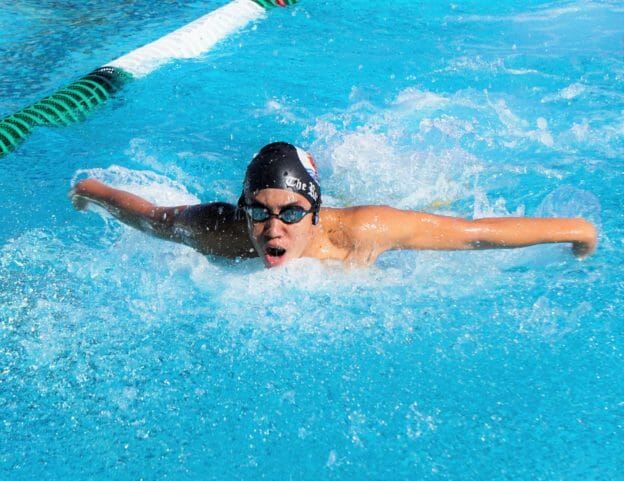Butterfly Technique
Our latest butterfly swimming technique video sheds some new light on this difficult stroke. While swimming proper breaststroke may be the toughest swim technique to learn or teach, from an energy expenditure standpoint, swimming butterfly is the toughest stroke to perform. Butterfly is a difficult swim stroke technique to do well. It is even a more challenging one to keep doing well throughout a race. Butterfly is an exhausting stroke.
One of the main reasons that swimming butterfly is so difficult is that it does not conform well to the law of inertia. It is an inefficient swim stroke. Because most of the propulsion in swimming butterfly coincides with the two down kicks during the stroke cycle, there is loads of down time when little or no propulsion is going on. That means that the swimmer’s speed is vacillating significantly between the two high points during the down kicks and the low points in between them. Because of the fluctuation in speed, swimming the butterfly technique requires lots of energy to keep going.
Swimming butterfly, like breaststroke, is also a very kick-dependent stroke. Unlike freestyle, where elite swimmers, like Gregorio Paltrinieri, can essentially pull their way to a great 1500 meter freestyle, no one can pull his or her way to a great 200 fly. Even less likely can one pull a fast 100 fly. Because in butterfly so much effort is required from the legs, these are the first thing to go in the race. In fly, once the legs go, so does the swimmer. End of race.
For anyone interested in improving butterfly technique, we start with the kick. Using Velocity Meter technology, Olympian Kelsi Worrell Dahlia taught us that there are actually four different points in the dolphin kick cycle where a swimmer can accelerate or increase propulsion; two on the down kick and two more on the up kick. Very few swimmers will capture all four points of acceleration. Most get one or two of them.
How to Improve your Butterfly Technique
Improving the dolphin kick while swimming butterfly is a process that takes time. It demands focus on improvement in three very different areas. First would be ankle plantar flexibility for the down kick. Second focus on the correct technique which would be undulation of the hip and bend of the knee. And finally tremendous strength and fitness is needed of the hip flexors, extenders, and the knee extenders.
This season we will produce many upcoming webisodes and write many Aqua Notes on the development of a strong dolphin kick. It is an important subject and there is a lot to discuss and teach. The strength of the second down kick in butterfly not only depends on the three factors that I mention above. It is also influenced by the kinetic energy from our upper body, arms and head, the so-called coupling motions. How the head should be positioned in butterfly is particularly controversial. Soon we will release a webisode featuring National Champion butterflier, Amanda Kendall. Using Velocity Meter technology we will show how the aggressive head snap down increases her propulsion.
This week in Lanes 2, 3 and 4 of our Race Club subscription, you will learn about an important drill to increase the energy of the coupling motions in butterfly. Kelsi demonstrates how to do this drill properly. Remember that coupling motions work well only when they couple with a strong propulsive force. That means for better technique, you need to work both down kicks and both up kicks in every swimming butterfly stroke cycle to get the most from your coupling energy.
Yours in swimming,
Gary Sr.

